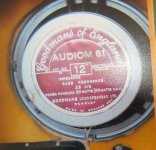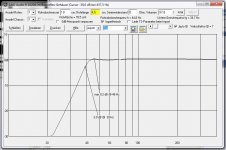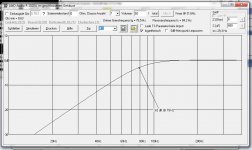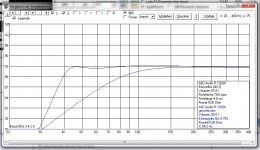Goodmans 12" Driver
Long ago (in the seventies), there was some discrepancy between amplifier- and speaker ratings between the Europeans and Americans. I came a cross this old three way Goodmans 12" photograph from a three way box that shows exactly that.
Long ago (in the seventies), there was some discrepancy between amplifier- and speaker ratings between the Europeans and Americans. I came a cross this old three way Goodmans 12" photograph from a three way box that shows exactly that.

Attachments
I have some of those which I'll be selling in due course. (Actually 4 Axiom 301s and 2 Audiom 51s).
The UK rating is a continuous sine-wave one. I'm not sure how the US rating was determined.
The field strength on the Audiom 61 (and Axiom 301) is very high, making the drive unit very efficient. The downside of this is that the Qes is very low. The resulting Qts is hard to match to any reasonable sized box. I know that people have successfully used a simple passive equaliser between the pre-amp and power amp on these with good results.
(That was in the pre-DSP days, when equalisation was a bit more difficult than it is now).
The UK rating is a continuous sine-wave one. I'm not sure how the US rating was determined.
The field strength on the Audiom 61 (and Axiom 301) is very high, making the drive unit very efficient. The downside of this is that the Qes is very low. The resulting Qts is hard to match to any reasonable sized box. I know that people have successfully used a simple passive equaliser between the pre-amp and power amp on these with good results.
(That was in the pre-DSP days, when equalisation was a bit more difficult than it is now).
The reason for the dual power rating was caused by the different standards used by amplifier manufacturers in the early Hi Fi industry. English manufacturers such as Leak specified power at 0.1% TH&N distortion and the American companies relied on the power measurement at a point just below clipping. An amplifier thus would be a 12 W model in one country and 17 W in the other. Unfortunately some people in England thought that peak power was being used and the ratings for speakers were doubled and referred to as USA watts. The world has moved on from those confusing days and thankfully there are agreed standards that are applicable to loudspeakers.
The 'Q' factor of a speaker is based on a single speaker. When a stereo system is considered, the effects of mutual coupling and room gain add considerable output in the L.F. region and in practice a much lower Qts is actually a desirable feature to have.
The 'Q' factor of a speaker is based on a single speaker. When a stereo system is considered, the effects of mutual coupling and room gain add considerable output in the L.F. region and in practice a much lower Qts is actually a desirable feature to have.
The world has moved on indeed.
The upper limit of hyperbolic claims now is in the kilowatts. For amplifiers sometimes using chip amplifiers capable of a fraction of this. Along with some amplifiers actually capable of this!
The numbers game has just changed in nature but remains little more informative.
The upper limit of hyperbolic claims now is in the kilowatts. For amplifiers sometimes using chip amplifiers capable of a fraction of this. Along with some amplifiers actually capable of this!
The numbers game has just changed in nature but remains little more informative.
The 'Q' factor of a speaker is based on a single speaker. When a stereo system is considered, the effects of mutual coupling and room gain add considerable output in the L.F. region and in practice a much lower Qts is actually a desirable feature to have.
That's plain wrong. The Qts does not change with the number of speakers. And the Qt (Q of the speaker in the enclosure) does not change with the number of speakers either, it only changes if you increase the number of drivers in the same volume. And The LF level ofcourse increases with a 2nd (stereo) speaker, but so does the complete frequency range it reproduces, therefore that does not affect the tonal balance (the placement does affect it however). And, finally, what Qts is desirable depends on the the wanted frequency range, and extremely on the enclosure principle. High Qts drivers are very good for TML, TQWT, open baffle, dipole, sealed and filtered sealed enclosures.
ICG, either you have used a translator to read post #4 or you have simply misconstrued the content of the message.No where is it implied that the Qts of a speaker is altered when a stereo system is considered. Indeed it well known that Qts is a T & S parameter measurement of a speaker driver on its own. I standby what I said, a lower Qts is of benefit when a stereo system is considered as mutual coupling and room gain add to the L.F. output.
Indeed it well known that Qts is a T & S parameter measurement of a speaker driver on its own.
You said something different.
I standby what I said, a lower Qts is of benefit when a stereo system is considered as mutual coupling and room gain add to the L.F. output.
See, again. That is simply wrong. The room gain applies to one speaker the same as for two. You don't know about logarithm, do you? +6dB is the same gain, no matter how many speakers you use. And no, a low or high Qts is neither good nor bad, that ONLY comes into play in conjunction with the enclosure! And a low Qts driver is preferred in BR, BP, horn while it's mostly useless in a sealed enclosure or TML etc. Take your preferred simulation program and try the latter enclosure types with a low Qts driver and you'll see they don't work. The QTS alone does not say anything about the response in the bass unless you put it in an enclosure of any type. It is only one (of several) specs which qualifies it best for enclosure type x or y. And even with high Qts drivers you can achieve good bassreflex results.
This is a 10" driver:
fs: 68.4 Hz
Qms: 3.93
Qts: 0.62
Vas: 25.7 Liter
So that's a high Qts. And it works fairly well in BR:
You don't believe me? So you don't like it that deep, you want to put the speakers near the wall or even corner? Or want a cleaner, leaner bass? NP, use a sealed enclosure:
Do you see now that the Qts does not say much unless you put it in an enclosure? And that the enclosure type changes the outcome vastly? Here the comparison:
Attachments
- Status
- Not open for further replies.
- Home
- Loudspeakers
- Multi-Way
- Goodmans 12" Bass Driver



